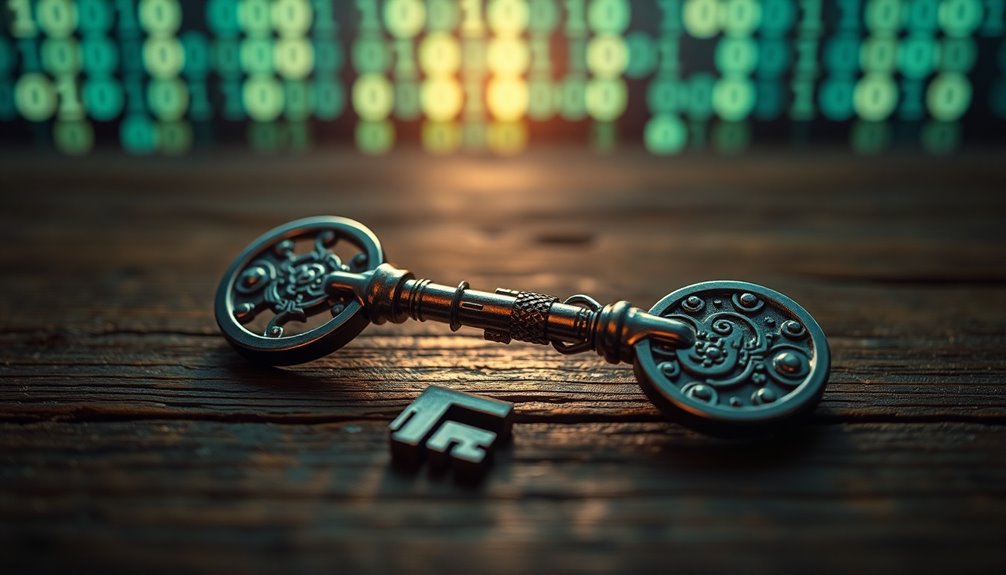A cryptographic key is essential for securing data in digital communication. It acts like a lock and unlocks for encryption and decryption. Depending on the type, you may use symmetric keys, which are the same for both processes, or asymmetric keys that involve a public-private pair. Proper key management is crucial, as weak keys can lead to vulnerabilities. Ensure you generate and distribute keys securely, updating them regularly to enhance protection. Learning about their lifecycle and associated best practices will equip you with the knowledge to keep your data safe.
Key Takeaways
- A cryptographic key is a piece of information used to encrypt and decrypt data, ensuring confidentiality and security.
- Keys can be symmetric (same for encryption and decryption) or asymmetric (public-private pairs), each serving different functions.
- The effectiveness of cryptography relies on the secrecy of the key, not the algorithm used, as per Kerckhoff's Principle.
- Proper key management includes generation, distribution, rotation, and destruction to mitigate vulnerabilities and protect sensitive information.
- Key sizes are crucial; current recommendations suggest using at least 2048-bit RSA or 256-bit ECC for strong security.
Key Types and Functions

When it comes to cryptographic keys, understanding their types and functions is crucial for secure communication.
You'll encounter symmetric keys, which use the same key for both encryption and decryption. Examples like Data Encryption Standard (DES) and Blowfish rely on shorter key lengths, speeding up processes but requiring secure exchanges between parties. Key life cycle management is essential to ensure the effective use of symmetric keys throughout their lifespan.
On the other hand, asymmetric keys involve a public-private key pair, allowing secure communication without prior exchanges. They're essential for generating digital signatures and establishing cryptographic materials.
Each key type serves specific functions, including encryption, digital signatures, and message authentication codes.
Understanding Key Importance
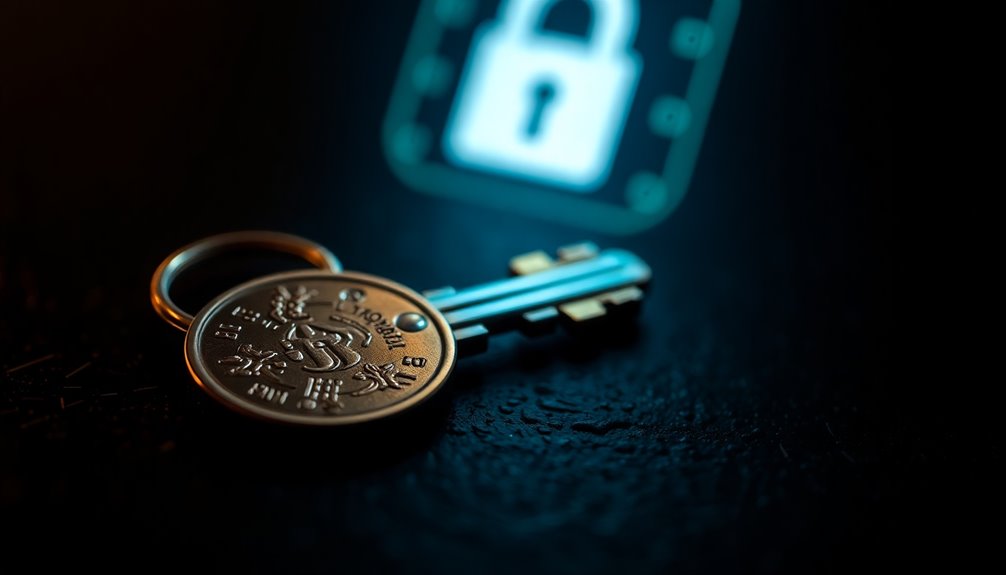
Cryptographic keys are the backbone of secure communication, playing a vital role in protecting sensitive information. Their secrecy is crucial, as Kerckhoff's principle states that the security of a cryptographic system relies on the key's confidentiality.
If a key is compromised, cybercriminals can easily decrypt data, impersonate users, or access classified information. Larger key sizes enhance security against brute force attacks, but they also demand more computational resources. Current standards recommend using 2048-bit RSA keys and 256-bit ECC keys to strengthen encryption.
Effective key management is essential for protecting, storing, and distributing keys securely. By following robust management practices, you can mitigate risks and ensure that your encryption remains effective.
As digital threats evolve, understanding the importance of these keys will help you safeguard your valuable information.
Key Generation and Distribution

Effective key generation and distribution are essential to maintaining secure communication. You can generate keys using random number generators (RNGs) or pseudo-random number generators (PRNGs) that mimic randomness. For added uniqueness, methods like mouse movements can create unique seeds.
You might also use key derivation functions to create keys from a passphrase. When it comes to types, symmetric keys encrypt and decrypt, while asymmetric keys involve a public-private pair. Moreover, utilizing fresh shared keys for each session can enhance security and prevent vulnerabilities in your cryptographic systems.
For secure distribution, consider public key infrastructure (PKI) or key agreement protocols like Diffie–Hellman. Remember to manage your keys wisely: confirm their accuracy, store them securely, and rotate them regularly to enhance security.
Prioritizing these practices will significantly strengthen your cryptographic foundations.
Pros and Cons

While weighing the pros and cons of cryptographic keys, it's crucial to recognize their significant benefits alongside potential drawbacks.
On the plus side, cryptographic keys ensure confidentiality, keeping your sensitive data safe from unauthorized access. They maintain integrity by preventing tampering during transmission, validating document authenticity, and confirming sender identities. Additionally, they support security compliance, reducing risks of data breaches. Furthermore, cryptographic keys play a critical role in ensuring secure communication, which is essential for transferring sensitive information over various channels.
However, the complexity of key management can be daunting, requiring specialized knowledge and continuous monitoring. Performance overhead may also slow down systems, particularly in resource-constrained environments. Finally, weak algorithms can leave your systems vulnerable, risking key compromise and exposing you to cyber threats.
Balancing these factors is essential for effective implementation.
Encryption vs. Decryption Keys
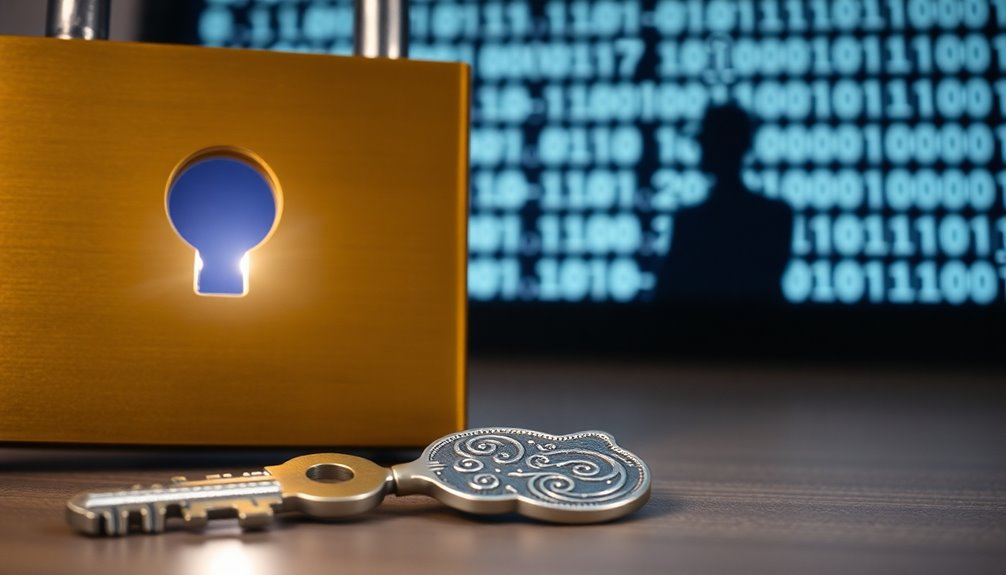
When you delve into the world of encryption and decryption keys, it's essential to understand their distinct roles in securing data. Encryption keys transform plaintext into ciphertext, making your data unreadable to unauthorized individuals. They can be symmetric, using the same key for both encryption and decryption, or asymmetric, employing a public key for encryption and a private key for decryption. Additionally, the use of secure key management practices is vital to maintaining the security of both encryption and decryption keys. Decryption keys, on the other hand, reverse this process, turning ciphertext back into readable plaintext. It's crucial that decryption keys match the corresponding encryption keys to ensure data integrity.
Vulnerabilities in Key Management
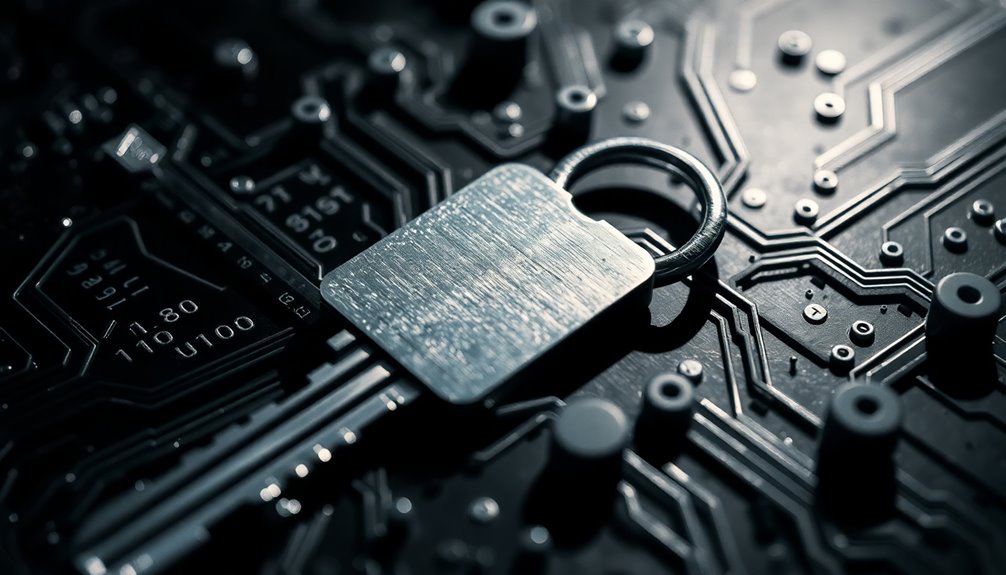
Key management is critical in maintaining the security of cryptographic systems, as vulnerabilities in this area can lead to significant risks.
Weak keys generated from outdated algorithms or predictable patterns can easily be guessed, allowing attackers to decrypt your data. Reusing keys across multiple systems increases exposure, while storing them in plain text makes them accessible. Cryptographic failures can occur when sensitive data is inadequately protected, leading to unauthorized access and data breaches.
Regularly rotating and securely destroying old keys is essential; failure to do so can lead to leaks. Additionally, improper implementation of cryptographic protocols and insecure random number generation can compromise your security.
To mitigate these risks, always adhere to industry standards and continuously monitor your key management practices for anomalies. This vigilance will help you protect sensitive information from unauthorized access.
Quantum Key Distribution Advances

As advancements in quantum technology continue to evolve, Quantum Key Distribution (QKD) is emerging as a groundbreaking method for securing communications. It leverages quantum mechanics, using entangled particles to generate secure cryptographic keys.
You'll find that QKD enhances efficiency and speed, thanks to innovations like Toshiba's Large-Scale QKD Network Control Technology and High-Speed QKD Technology. These technologies optimize key distribution routes and allow multiple QKD systems to operate on a single fiber, achieving impressive speeds. Additionally, the network features optimized key relay routes to further enhance the efficiency of quantum key transfers.
Real-world applications are already visible in sectors like finance and telecommunications, with companies like SK Telecom and Verizon testing QKD solutions. As these technologies develop, QKD shows great promise for providing robust security in an increasingly digital landscape.
Regularly Update Key Materials
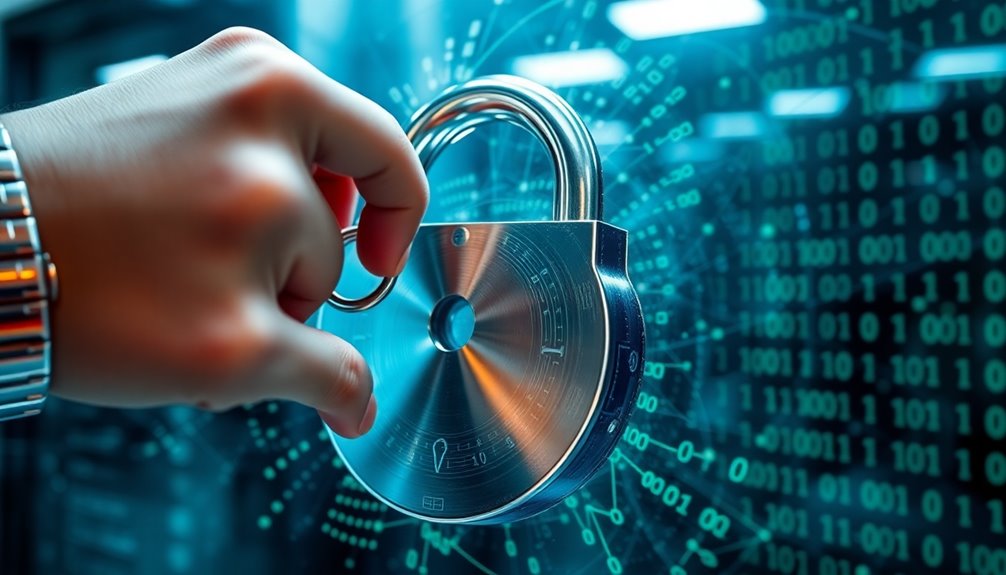
Regularly updating key materials is crucial for maintaining robust security in your cryptographic systems.
Automate the key rotation process to reduce operational overhead and minimize human error. Use secure protocols for rotation and adjust the frequency based on data sensitivity. In high-risk environments, consider rotating keys more often.
Generate new keys with high-quality random number generators and use trusted cryptographic modules like HSMs for their creation. Don't forget to securely destroy old keys after rotation.
Monitor key usage patterns to detect potential misuse and ensure compliance with standards like FIPS 140-2. Regular audits will help you verify adherence to key management policies, keeping your security measures current against emerging threats. Additionally, implementing key management practices is essential for preventing unauthorized access to sensitive information.
Frequently Asked Questions
How Long Should a Cryptographic Key Be for Security?
When you're choosing a cryptographic key length for security, aim for at least 256 bits for symmetric algorithms like AES and 2048 bits for RSA.
Longer keys are crucial to protect against brute-force attacks and evolving threats. Remember, the longer the key, the harder it's for attackers to crack it.
Always stay updated on recommendations, as computational power grows and the landscape of cybersecurity changes. Your choice should reflect your specific security needs.
Can Cryptographic Keys Be Reused Safely?
You can't safely reuse cryptographic keys. Doing so opens you up to various security vulnerabilities, like impersonation attacks and data breaches.
Each key should be unique to its application or device to prevent risks like cross-protocol attacks. Instead of reusing keys, implement best practices like key rotation and secure storage.
What Is a Key's Lifespan Before It Should Be Replaced?
A key's lifespan before it should be replaced depends on several factors.
You need to consider the sensitivity of the data, the volume being protected, and the key's strength. Typically, key rotation occurs every few months or after a certain number of transactions.
If you're dealing with high-value data or facing skilled adversaries, more frequent replacements are essential.
Following industry guidelines helps ensure your keys remain secure and compliant.
How Are Keys Stored Securely?
To store keys securely, you use hardware security modules (HSMs) for tamper-resistant storage, leverage key vaults like Amazon KMS for centralized management, and implement encryption techniques to protect keys from unauthorized access.
You also control access through authentication and role-based measures while applying multi-factor authentication for added security.
What Happens if a Key Is Lost?
If you lose a key, you might find yourself locked out of your sensitive information, like private chats and blog history.
Without that key, you can't decrypt your data, which could lead to significant setbacks.
You'll need to create new keys or re-encrypt your accounts upon re-logging in.
To avoid this, it's crucial to back up your keys regularly, ensuring you don't face the consequences of data loss or inaccessibility.
Conclusion
In the world of cryptography, you might not realize how crucial a key is until you need it. Just like finding the right key to unlock a door, having the proper cryptographic key can mean the difference between secure communication and a data breach. So, as technology evolves, stay ahead by regularly updating your key materials. Remember, a small oversight could cost you dearly, but a proactive approach keeps your information safe and sound.
